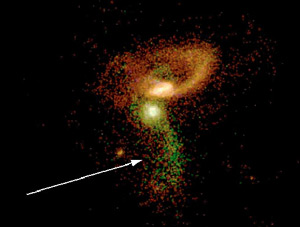The European Southern Observatory just released this lovely picture of NGC 520, two galaxies in the middle of the long, long process of colliding:
[Click to galactinate.]
NGC 520 is pretty far away, about 100 million light years. Still, even at a glance you can tell something is fishy* about it. Colliding galaxies like NGC 520 are relatively common; hundreds of examples are known. These galactic train wrecks can take billions of years to unfold, and in this case the two galaxies have probably been at it for 300 million years or so. They’re well on their way to merging to become one much bigger galaxy, probably the size of the Milky Way: 100,000 light years across. We think our own galaxy grew over time in this way.
 And if NGC 520 looks familiar to you, that may be because you’ve been reading this blog for more than a week. It was only a few days ago that I posted a stunning video showing a scientifically and mathematically-produced animation of how some scientists think two large galaxies collided and merged, forming the Andromeda Galaxy as we know it today.
And if NGC 520 looks familiar to you, that may be because you’ve been reading this blog for more than a week. It was only a few days ago that I posted a stunning video showing a scientifically and mathematically-produced animation of how some scientists think two large galaxies collided and merged, forming the Andromeda Galaxy as we know it today.
Shown here is a still from that animation (flipped horizontally) which looks remarkably like NGC 520, don’t you think? The gas and dust in the real galaxies obscures the details somewhat, but you can see a lot of the same features, including the long streamer of stars (called a tidal tail, incicated by the arrow) which gets drawn out due to the gravitational interaction of the two behemoths.
The physics of galaxy collision is complex, of course, but it can be simplified quite a bit. When astronomers started modeling collisions, computers weren’t nearly as powerful as they were now, and couldn’t make as many calculations as quickly. So the astronomers would simplify hugely, assuming gravity is the only force at work, and model galaxies as a few thousand stars orbiting each other – in reality, gas flows and collides, stars form and die, and galaxies are collections of billions of stars. And yet, even with those crude models, the results looked remarkably similar to what we actually see happening in the sky! Obviously, details are important, but sometimes you can get most of the way to your goal with just a few simplifications. Perhaps there’s a life lesson there.
Anyway, when we look at NGC 520 we may be getting a glimpse of what Andromeda looked like a billion or two years ago, and maybe what our own galaxy looked like in its distant past. That’s one of the reasons we study such objects, so that we may understand our past.
But also? Because they’re just so freaking cool.
Image credits: ESO; GEPI, Observatoire de Paris / NAOC
* … which has nothing to do with it being – and this is true – located in the constellation of Pisces.